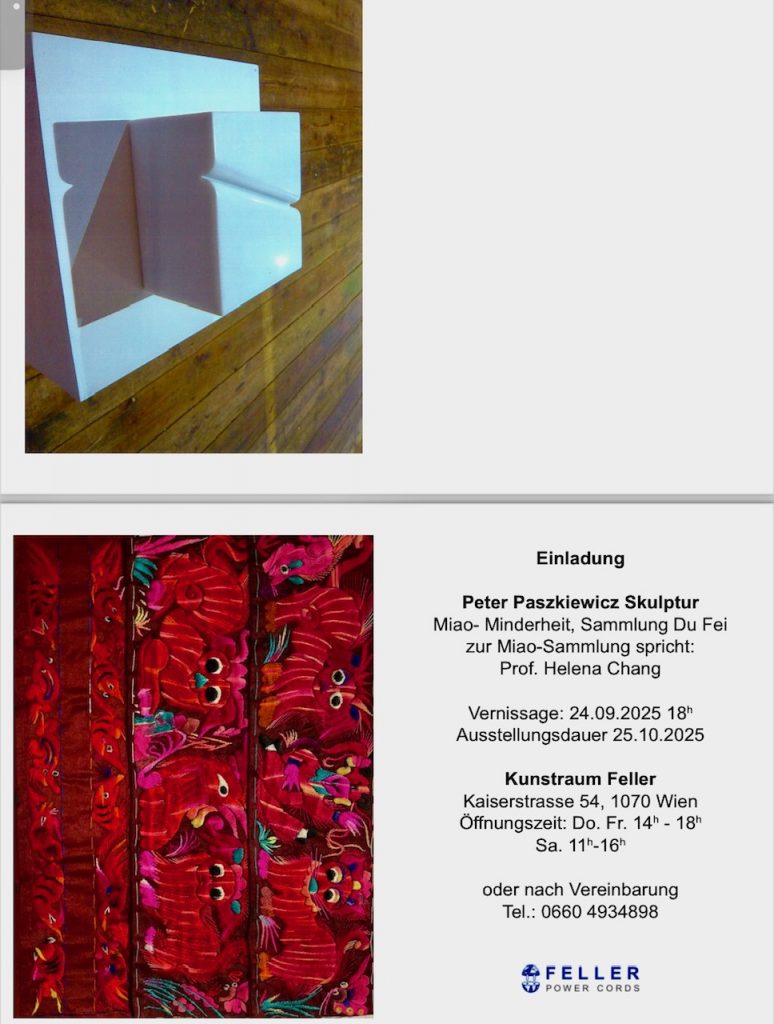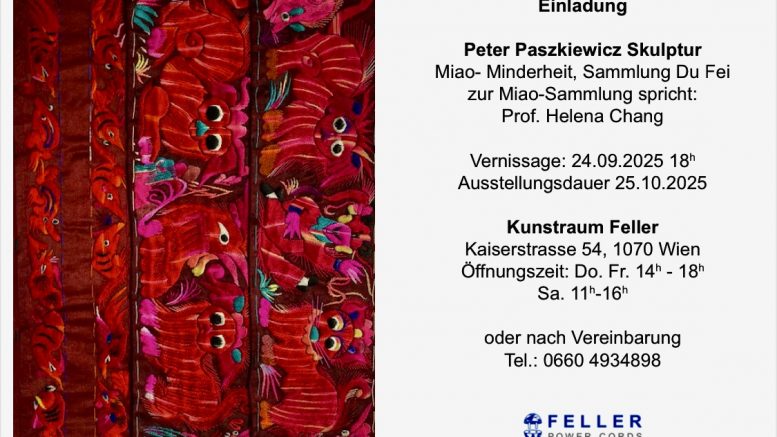Miao embroidery, visually colorful and captivating, is an ancient art by the Miao people in China. Geometrically symmetrical, aesthetically imaginative and technically complicated, it is a unique, encyclopedia-like means to document the long history of Miao’s who does not have a written language of their own’s throughout history.

The exhibition opening at Kunstraum Feller on 24. September in Vienna will exhibit a valuable collection of Miao embroidery by Ms. Mag. Du Fei in the late 1970s and 1980s. During this time, she traveled to many places in Guizhou, particularly the remote gathering places of the Miao ethnic group. Among the items on display are the embroidered pieces for collars, sleeves, and the front part of a garment. Precious ready-made garments and pleated skirts are shown, too, plus traditional handcrafted silver jewelry.
The origins of Miao embroidery date back to ancient times. During the Warring States Period (between 475 BC and 221 BC), Miao embroidery officially appeared on Miao clothing. The Yuan, Ming, and Qing dynasties saw Miao embroidery patterns and styles varying greatly, as different Miao tribes used different animals as totems.
In retrospect, Miao embroidery is inseparable from the carved tattoos of the ancient Pu people (an ancient ethnic group living in southwest China, specifically Yunnan, Guizhou, and other places). The Miao people are part of the Pu lineage, called Nanman.
The Miao people originate from the northern Chinese tribal alliance of the Jiuli, though, with the legendary Chiyou as their ancestors. Over time, however, they experienced several large-scale migrations from the Yellow River basin to the middle and lower reaches of the Yangtze River, and then to Guizhou, Yunnan, and Hunan. Others also migrated to Vietnam, Burma, Laos, Australia, North America, and Europe.
As the Nanman people mastered sericulture, carved tattoos gradually evolved into “drawings.” With the advent of bone and copper needles, cross-stitch and weaving techniques emerged. Miao embroidery developed unique expressive techniques and artistic language, which continue to arouse curiosity and fascination. The handicrafts are rich and diverse. There are several dozens of knitting methods, including flat embroidery, braid embroidery, wrap embroidery, double-needle lock embroidery, crepe embroidery, and silk floss appliqué embroidery, to name a few. Whether intricate or crude, these handicraft techniques are endowed with enchanting artistic charm. Traditionally, Miao embroidery is not done directly into clothing, but rather as pieces of embroidery placed on top of the garment cloth material.
Miao folks sometimes use tin metal on navy blue cotton fabric. The fabric is first threaded with cotton thread according to traditional patterns, then strips of tin metal wire are embroidered into the patterns, and finally, colorful flowers are knitted into the gaps between the patterns using black, red, blue, and green silk threads.
Miao embroidery does not pre-design anything. Each piece is crafted with unique improvisation. The patterns are elegant, colorful, and often spiritual, incorporating mysterious elements to call God-like beings or the ancestors to the garment as the protector of the person wearing it. One can say that while the patterns are inspired by real life, they interact with the gods. Miao women attentively observe and experience flowers, grasses, trees, birds, insects, fish, and other phenomena in nature. Through artistic abstraction, they boldly exaggerate and distort to express the aesthetic feelings, philosophical thinking, and ideals of the Creator. In this sense, Miao embroidery is different from other embroideries of China and of higher aesthetic value. – The famous four embroideries of China (Su embroidery, Xiang embroidery, Shu embroidery, Yue embroidery) typically focus on everyday phenomena and concrete objects.
There is an intrinsic element in Miao embroidery: butterfly. For the Miao people, Mother Butterfly is the symbol of creation. The legend tells that she fell in love with water and laid 12 eggs. 11 of them formed everything in the world. But only after three years and with the help of the divine bird Jiyu did she manage to hatch the 12th egg as Jiangyang, the ancestor of humans! The Miao people have infinite respect for Mother Butterfly. The patterns of Mother Butterfly can be seen everywhere in the embroidery, though they are often hidden or abstract. It has thus become a standard to judge if the piece is original, genuine or fake with the Mother Butterfly pattern when collecting.


Be the first to comment on "Exhibition of Miao Embroidery Collection by Du Fei Opening Soon in Vienna"